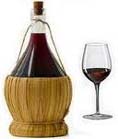Decanters
from Italian Traditional Food
Decanters are a byword for
elegance
Check out these great Italian ideas at Amazon for Italian food and kitchen ideas.
In the 17th century, claret was the well-to-do Englishman’s favourite tipple. As it was served
cold and stored in its cask, the only thing necessary between the cask and the drinker’s glass was a stout serving
bottle of thick, greenish glass, for the servant to transport the liquor to the table.
These early bottles were of a shape called “shaft and globe”, and consisted of a bulbous base
surmounted by a long, thin neck. Some of the earliest decanters were made in this shape,
which was revived with great success by the Victorians.
Decanters gained popularity
So it was not until the Englishman adopted port as his favourite drink in the 18th century that
the decanter came into its own. It was found that this fortified wine actually improved from careful storage and by
being poured into a smaller container to settle and acquire room temperature.
Decanter styles
By 1750, glass decanters had gained ground-glass stoppers to prevent
evaporation, and several identifiable shapes were in evidence. In addition to the shaft and globe, you would find
the straight-sided “mallet” decanter, the shoulders of which curved and lengthened as the century progressed until
it became the tall, elegant “shouldered” decanter so popular in the 1770s. Then there was the “club” shape, with
rounded sides that tapered towards the base.
The first “label” decanters appeared soon after, with names such as claret, mountain and
hollands (gin) engraved on the body. Towards the end of the 18th century the shape changed.
The Regency period decanters
The Regency period brought drum-shaped bodies with sloping shoulders and short necks, the latter
having two or more rings to give a reasonable grip when pouring. Elaborate cutting came into fashion at the
beginning of the 19th century, especially on the Waterford decanters with their characteristic “mushroom” stoppers.
And all these styles remain with us to the present day – eminently collectable.
Read more Italian traditional food related articles here

Copyright © 2009 - . All Rights Reserved
Worldwide. Italian Traditional Food
You may not reprint articles from this website
without the written permission of the site owner.
Disclaimer: Articles on this
Website are provided for information purposes only. Italiantraditionalfood.com does not accept any responsibility
or liability for the use or misuse of the article content on this site or reliance by any person on the site's
contents.
| 


 Digg
Digg Stumbleupon
Stumbleupon Google Bookmarks
Google Bookmarks Delicious
Delicious Twitter
Twitter Facebook
Facebook Yahoo My Web
Yahoo My Web Reddit
Reddit